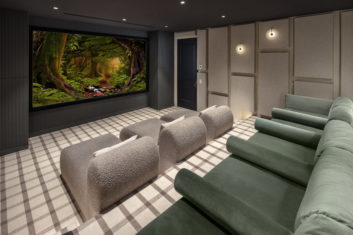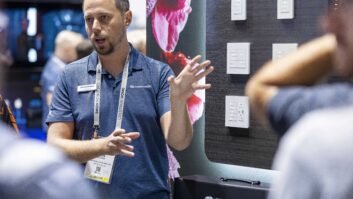 The recommended practice for the design of performance for residential AV spaces is changing, and it’s changing dramatically.
The recommended practice for the design of performance for residential AV spaces is changing, and it’s changing dramatically.
CEDIA and the Consumer Technology Association run a joint standards committee named R10, which was formed to create standards and recommended practices for the installation and integration of technology into primarily residential environments.
The R10 group, overseen by CEDIA senior director of technology & standards, Walt Zerbe, consists of over 130 volunteer members, including integrators, manufacturers, protocol suppliers, members of other associations like SMPTE, DTS, and Dolby, content creators, and more.
All About Recommended Practices (RPs)
Within the R10 group, there are a few RP (Recommended Practice) sub-groups: RP22, RP23, and RP1. The first of these three endeavours, RP22: Immersive Audio Design Recommended Practice, is a revision of the CTA/CEDIA-CEB22-B Home Theater Recommended Practice: Audio Design.
RP22 is described by Zerbe as “a major three-year revision,” that includes immersive audio, universal speaker layouts for all formats, an expanded bass management section, coverage, seat-to-seat variation, and performance levels.
RP22 defines performance targets for reference as well as two levels below and one above. There are 21 parameters that are predictable at the design engineering phase of a project and measurable at post-commissioning and calibration phases. Level 1 is the minimum that is considered able to convey basic artistic intent, level 2 is increased performance, level 3 is reference, and level 4 exceeds reference.
“For the first time, we will have objective rather than subjective definitions of in-room performance,” says Peter Aylett, partner at Officina Acustica and 2022 CEDIA Fellow inductee.
RP22 will help integrators:
- Compete on a level playing field by proposing systems based on performance levels
- Deliver consistent user experiences through the application of engineering
- Separate themselves from the untrained DIY and DIFM markets by bringing engineering integrity to systems
- Deliver systems that are signed off on objective metrics
- Select the correct products through engineering specification facts
Why We Need RPs
Standards and recommended practices give the smart home industry credibility among other industry associations, adjacent trades, and the design/build community.
“Professional CI is under huge pressure from the mainly consumer Giga-companies who are offering increasingly compelling user experiences through the retail/DIY channel,” says Aylett. “Standards will help professional integration companies apply a human-centric, engineering-based approach as opposed to a product-based one.”
As part of the Smart Home Technology Conference at ISE, CEDIA is hosting a training course entitled RP22 Immersive Audio System Design Recommended Practice Workshop on 2 Feb at 2.30 p.m. Visit Conference Suite CC1 to book onto the session.







